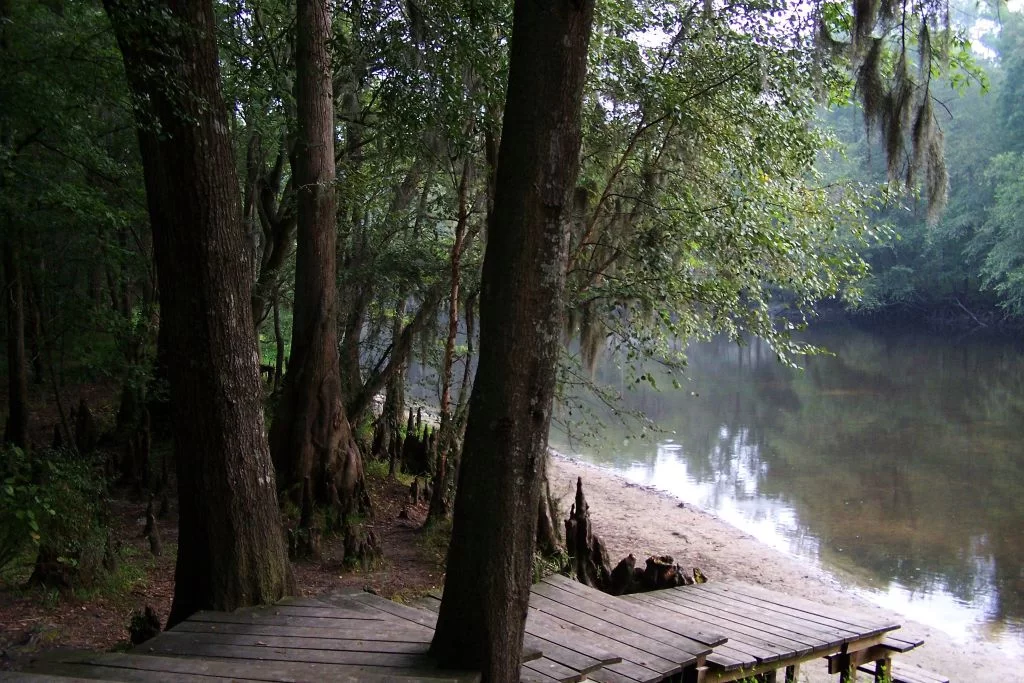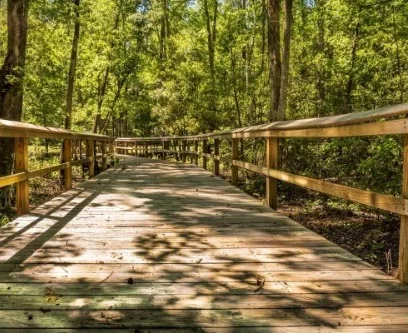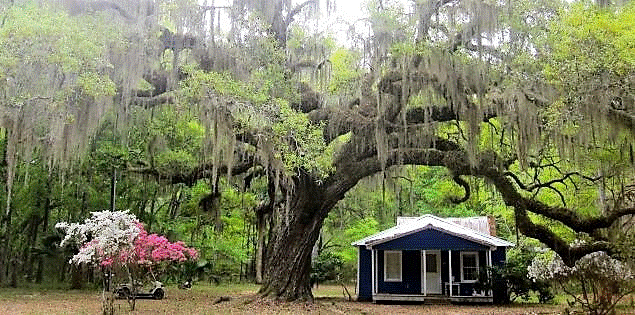
Exploring SC Lowcountry Parks is a great way to get outdoors! During these stressful times, it is important for us to maintain our connection with nature. While we’re all social distancing and staying home, it’s a good idea to get outdoors and soak up sunshine and fresh air. If we take precautions and listen to the guidelines put in place by our leaders, exploring a park is just what the doctor ordered! Colleton, Beaufort, Hampton and Jasper Counties have a multitude of outdoor possibilities to connect with nature. For additional information and maps of these properties visit https://southcarolinalowcountry.com/wildlife-preserves-and-nature-trails/.
Colleton County and Walterboro have some wonderful parks and wildlife management areas. Whether you want to stretch your legs or take a scenic car ride, these natural wonders have something for everyone.

The ACE Trail is located two miles north of the intersection of Hwy 17 and SC HWY 303 in Green Pond. This trail runs along the abandoned Atlantic Coast Railroad Line that parallels SC Hwy 303. This trail is currently 2.8 miles, but another extension is planned soon. The trail is ideal for walking, biking and bird watching. The trail head has picnic tables and plenty of space for parking.

Colleton State Park borders the Edisto River. Here, you’ll find a short, easy walking loop trail that travels along the river. Signs are placed along the trail to help you identify a variety of trees and plants, including Cypress trees. While here, look for birds, deer, turtles and other wildlife. The park can be found at 147 Wayside Lane, Walterboro – just a few miles off I-95.(843)538-8206

Ernest F. Hollings ACE Basin National Wildlife Refuge has trails that weave through the forest and across dikes of a historic rice plantation. The refuge also has one of the few remaining antebellum houses in the area. This refuge protects the largest undeveloped estuary along the Atlantic Coast. The area is home to a wide variety of wildlife. The refuge is located at 8675 Willtown Road, Hollywood, SC, on the way to Edisto Beach. (843)889-3084

Photo by Rhonda McFadden Epper.
Bear Island Wildlife Management Area is located off Hwy 17 in the Green Pond area. This wma is managed to provide quality habitat for wintering waterfowl. It’s a great spot to view bald eagles, wood storks and roseate spoonbills. Drive through this area for many opportunities to spot wildlife. The forest, marsh and river views are beautiful. Bear Island is located between the Asheepoo and S Edisto Rivers. From Hwy 17, turn onto Bennett’s Point Road and follow for 13 miles. The entrance is on TiTi Road. (843)844-8957

Donnelley Wildlife Management Area has more than 8,000 acres of diverse wildlife habitats. This property features a historic rice field system that is now managed to attract waterfowl and migratory birds. The former rice plantation is nestled between the Combahee and Asheepoo Rivers. All types of wildlife can be found here. There are 11 miles of roads that can be driven through the property. There are also walking trails that lead to dikes that cross old rice fields. Herons, egrets, ibises and many more varieties of birds can be found on this freshwater wetland. Located at 585 Donnelley Drive in Green Pond. The entrance is at the intersection of US Hwy 17 and SC Hwy 303. (843)844-8957

Just three minutes of I-95, the Walterboro Wildlife Sanctuary is a great place to get back to nature. There are trails for hiking, biking and even canoeing. This wildlife sanctuary is in the heart of downtown Walterboro. Parking can be accessed on DeTreville Street. Boardwalks lead through a braided creek with a diversity of wildlife that inhabit the black water bottomland. (843)538-4353

Botany Bay Plantation Wildlife Management Area can be found on the way to Edisto Beach. This wildlife management area borders the Atlantic Ocean and the North Edisto River.
Beach access is closed until further notice, but the remainder of the property is open. Drive through this undeveloped wetland ecosystem, then park to walk trails located throughout the property. The remains of two plantations can be explored here. You can even trailer in horses and go for a ride along the many roads of Botany Bay. The entrance to the property is one of the most photographed live oak canopies in the lowcountry. Many varieties of birds and wildlife call this coastal property home. (843)844-8957

Edisto Beach State Park is located on the beach and its adjacent maritime forest. The park has seven trails that are available for hiking, biking and birding. The trails wind through the forest and past the earliest Native American shell mound site in the state. A series of short, mostly level hikes travel through Edisto Island’s maritime forest of live oak, hanging Spanish moss, and palmetto trees. During your walk you may see white-tailed deer, osprey, raccoons, or alligators, and may even catch a glimpse of the wary bobcats.

Beaufort’s Spanish Moss Trail is the product of the Lowcountry’s Rails to Trail program. The ten- mile trail follows the path that the railroad took from Yemassee to Parris Island, carrying recruits to the training facility. The rail lines were removed, and the trail was paved for walking, running, biking, fishing, skating, scooting and strolling. The Spanish Moss Trail offers spectacular river and marsh views, and a great opportunity to view wildlife. Historic points are noted along the trail.

Hunting Island State Park is located on the beach and its maritime forest. The park has wonderful hiking and biking trails. The park’s walking nature trails provide an opportunity to experience the island’s natural environment. The biking and hiking trail is 8 miles long. The trails lead through the maritime forest, providing scenic views of the lagoon and various wildlife habitats. The trails have dense vegetation that provides protected habitat for many animals including deer, raccoon, owls, hawks and squirrels. Walk the beach to search for shells and shore birds. Bring a picnic and pick from one of the many spots to enjoy lunch.

Crystal Lake Park can be found just across the bridge on Lady’s Island. This 25 acre park winds through forested habitats, salt marsh and around Crystal Lake. The park has many opportunities for visitors to learn about the Lowcountry’s natural resources. Walk the trail or visit the interpretative center. Be on the look-out for birds and other wildlife that makes the park home. Catch and release fishing can also be done from the docks.
124 Lady’s Island Drive, (843) 255-2152

Port Royal has two natural habitats to explore that are located relatively close to each other. You can visit both in one day. Cypress Wetlands Walking Trail is located on Paris Ave right off Ribaut Road, with parking on Paris Avenue. There are several species of birds that call this place home including herons, hawks, eagles, owls, falcons, geese, ducks, and other migratory waterfowl. It is absolutely a birdwatcher’s paradise. In addition to birds, regular visitors among the cypress trees are alligators, turtles, and snakes.

The Henry Robinson Boardwalk is a great place for a stroll. Enjoy the wildlife while walking along the vast waterway. Located on the southern tip of Port Royal, Battery Creek flows into the Beaufort River. Search for shark’s teeth on the sandy beach. Boats and kayaks can be launched from a ramp into the river. The boardwalk is a popular place for strolling, crabbing and fishing. An observation tower is located near the end of the boardwalk. (843)986-2200

Bluffton’s Victoria Bluff Heritage Preserve is located in Bluffton off Hwy 278 on Sawmill Creek Road. Spend a day hiking, bird watching and picnicking. Avoid the preserve during hunting season. The area is used for bow hunting. Birders will want to bring binoculars and keep a sharp eye out, particularly in the spring. The understory thickets are dominated by saw palmetto and a range of evergreens. This habitat is ideal for migratory species such as tanagers, white-eyed vireos and a host of different warblers. Overhead, massive live oaks, and longleaf and slash pines cast deep shadows on the trail. In no time at all during a midday walk, things get cool and quiet.

Hilton Head Island is commonly known for its beaches and golf community, but did you know there are many places to enjoy nature? Audubon Newhall Preserve is located at 55 Palmetto Bay Road. The birds are singing, and the plants and nature trails are in top condition for spring. This woodland ecosystem is known as pine/saw palmetto flatwoods. The preserve has a series of short, easy walking trails through the fifty-acre property. Pick up a trail guide at the entrance which will guide you through a wide variety of trees and plants, from Florida Scrub to native hardwoods. (843)785-5775

The Coastal Discovery Museum https://www.coastaldiscovery.org/nature trails are open for walking and picnicking. Tale a leisurely stroll around the 68-acre property. The seashell nature trail leads to Jarvis Creek, and the camellia garden boasts 120 different varieties of bloom and color. (843-689-6767)

Jarvis Creek Park is located at 50 Jarvis Creek Road. The park was closed April 1st but will reopen on May 7th. The park is great freshwater pond fishing. There’s a floating dock and grass meadow. There’s a paved pathway that surrounds the lake and a fitness trail. Call the park for opening date. (843) 341-4600

Pinckney Island National Wildlife Refuge is located between Hilton Head Island and Bluffton. 4,052 acres that preserve the salt marsh and maritime habitat. The refuge offers a variety of opportunities to explore and enjoy the great outdoors from sunrise to sunset every day. You can observe and photograph wildlife, go fishing, hike or bike the 14-miles of roads that wind across the island. (843) 784-2468

Sea Pines Forest Preserve is a protected area for wildlife habitat and outdoor exploration. The preserve includes bridle paths, wetland boardwalks, bridges and fishing docks. Explorers can pick up a map and stroll the trails independently. View marshes and wildlife from a boardwalk at Old Lawton Rice Field. Explore a secluded forest on the boardwalk through the Vanishing Swamp. Discover the 4,000-year-old Sea Pines Shell Ring, which is listed on the National Register of Historic Places. See acres of native flora in bloom. Enjoy a picnic along the banks of Fish Island. (843) 785-3333

Ridgeland’s Blue Heron Nature Trail is a 10-acre green space that has a half-mile trail around a three-acre pond, and forested wetlands. The property also includes a butterfly garden, picnic area, and observation decks. Trail side displays help visitors learn more about the native flora and fauna of Jasper County and the Lowcountry. Exit 21, Ridgeland, (843)726-7611

Savannah National Wildlife Refuge is located off US Hwy 17, between Hardeeville and Savannah. Many visitors take the car tour through the former rice plantation, but did you know there are 40 miles of hiking trails through the 7,000-acre refuge? Jasper County’s Savannah National Wildlife Refuge consists of 31,551 acres of freshwater marshes, tidal rivers and creeks, and bottomland hardwoods. Well-maintained hiking trails wind throughout the refuge, giving hikers and bikers access to these former rice fields. Explore the nearly 40 miles of trails that are built on dikes that contained rice fields dating back to the early 1700’s. (843) 784-2468

Hampton has two great places to get some exercise in the great outdoors. Webb Wildlife Management Area is located off Hwy. 321, bordering the historical Savannah River. The 5,866 acres encompass upland pine stands that host endangered species such as red-cockaded woodpeckers, as well as wildlife openings, bottomland hardwood forests and cypress-tupelo swamps. The property provides excellent viewing of deer, wild turkeys, bobwhite quail, gray squirrel and many types of birds. Several nature trails can be found on the property. Ponds are available for fishing. 1282 Webb Ave, Garnett. (803)625-3569

Lake Warren State Park is located in Hampton. The park has three trails for outdoor enthusiasts. The nature trail winds through the woods and around the fishing pond. The fitness trail has 10 exercise stations. The Yemassee Trail follows a path along Lake Warren. Interpretive signs are placed throughout. There are also fishing opportunities at the park. (803)943-5051

For more information, trail maps and websites to these Lowcountry natural wonders visit https://southcarolinalowcountry.com/wildlife-preserves-and-nature-trails/









































































































































































